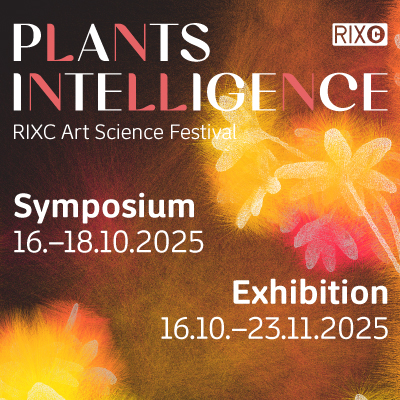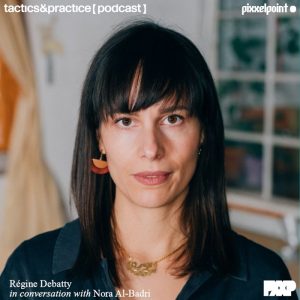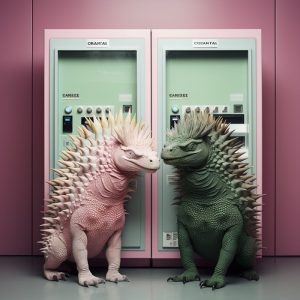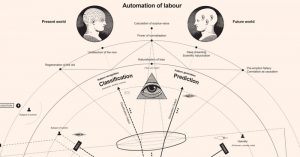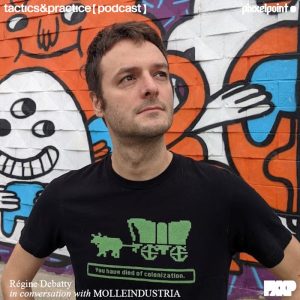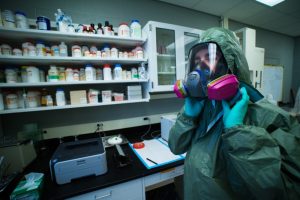Throughout her research-based practice, artist Kyriaki Goni constructs stories about machine learning, climate crisis, data sovereignty and the many connections between human and non-human life (both machinic and organic.)
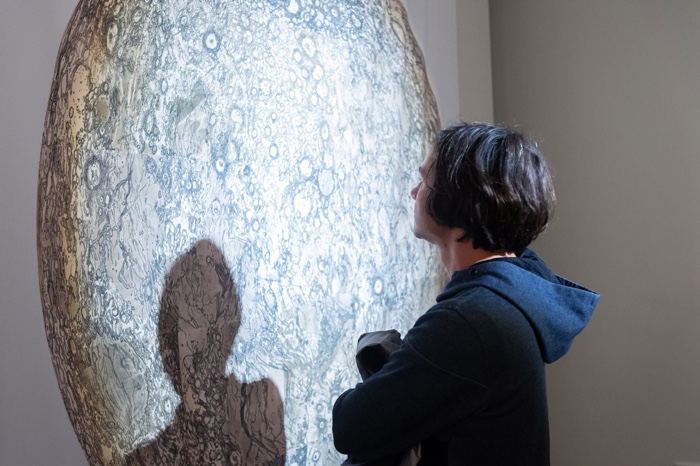
Kyriaki Goni. Counting Craters on the Moon, 2019. Installation shot, Aksioma Project Space, Photo: Janez Janša curated by Daphne Dragona
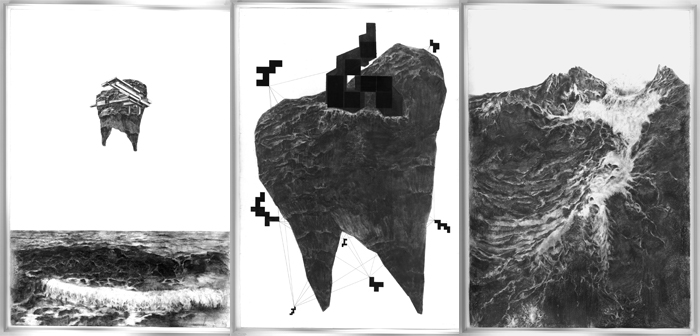
Kyriaki Goni, The Aegean Datahaven, series of drawings on paper, 2017
In Data Garden, she imagines how a rare plant endemic to the Acropolis hill could one day secretly host our digital data in its DNA. The project Aegean Datahaven depicts a future decentralised network of small, sustainable data havens on islands of the Aegean Sea that operate as a counter model to the predominant cloud infrastructure. Counting Craters on the Moon sparks a collaboration between 19th century astronomer Johann Friedrich Julius Schmidt and the CNN DeepMoon to calculate how many craters cover the surface of Earth’s natural satellite. As for her video The Perfect Love #couplegoals, made from images hashtagged with #couplegoals, it acts as a mirror to our society’s declared aspirations and cringe self-display.

Kyriaki Goni, Voices (Imagining Possible Futures), 2021. At FMR21 in Linz. Photo: (c) Jürgen Grünwald
Rooted in science and history, her speculations engage in a poetic way with everything that makes the future both daunting and intriguing. Another characteristic of her work is the way it often invites members of the public to join her investigations. Through workshops but also through artworks which content relies on public participation.
Right now, for example, Goni’s flags are floating all over the city of Linz for the FMR festival. The work, titled Voices (Imagining Possible Futures), started with people from Athens, Berlin, Istanbul, Manchester and the Aegean islands hypothesising about the possible futures of climate breakdown, population movements and technology. Short phrases were selected from their texts, printed onto flags and displayed in the public space. The flags form a kind of community narrative full of hopes and doubts. They offer passersby a pause to stop and read, and maybe also start pondering themselves about what futures await them. The original texts were hosted on the offline digital network Networks of Trust using the P2P protocol IPFS.
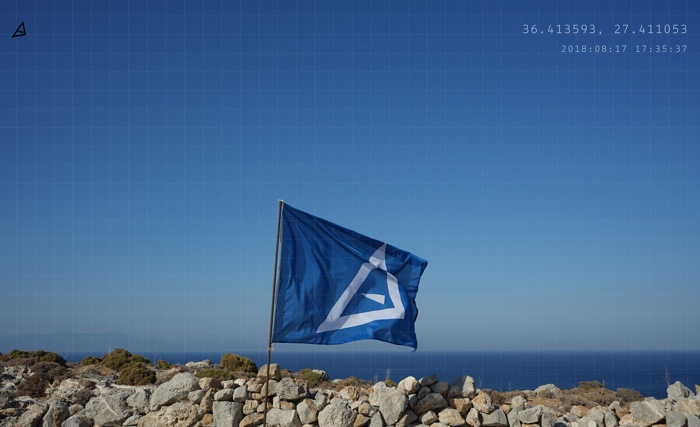
Kyriaki Goni, Flag of the Networks of Trust on island in the Aegean Sea, 2019. installation shot, 13,700,000 km3 Art Space Pythagorion curated by Katerina Gregos
I can’t be in Linz for obvious reasons but that didn’t prevent me from taking the FMR festival as an excuse to get in touch with Kyriaki Goni and ask her many questions about her work:
Hi Kyriaki! You have a background in social anthropology. How much does this training influence your artistic practice?
During my studies on fine and digital arts, I haven’t thought that my previous training in social anthropology would influence my future practice. Now that I have completed a first body of work, I realize that quite often I am unconsciously following a methodology related to social anthropology.
I carry out extensive research that includes interviews, archival material, workshops (interaction with communities) and sometimes, when possible, fieldwork. However, this is not a linear process for me. Instinct and gut feeling play an equally important role in my work. These obviously are formed from my lived experience: being a (digital) citizen of here and now, a woman living in Athens, a city at the intersection of East and West, in the European periphery.
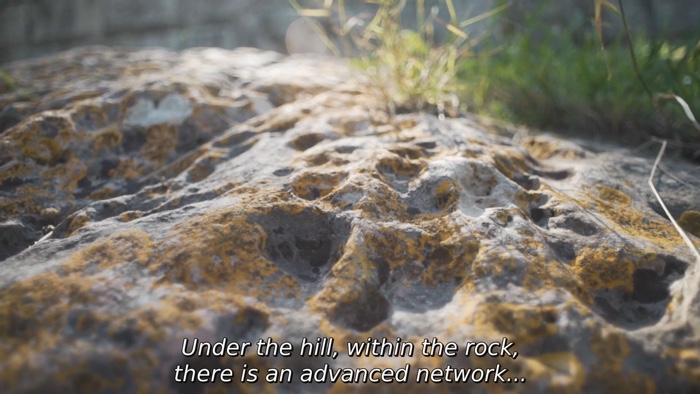
Kyriaki Goni, Data Garden (film still), 2020
Data Garden centres around a group of people who store their digital data inside the DNA of Micromeria acropolitana, a plant endemic to the Acropolis. Was it important that this specific plant is so closely connected to one of the symbols of democracy, philosophy, knowledge and Western culture? Why not imagine that the community keeps its digital memory in the DNA of flowers grown on a balcony, for example?
Storing the digital memory in the DNA of Micromeria acropolitana plays an important role in this narrative.
The first profound reason is that Acropolis stands as one of the symbols of democracy, philosophy, knowledge and Western culture. Nowadays western democracies are challenged in various ways. I focus mainly on the ways tech monopolies threaten or destabilize them. It’s not by chance that Acropolis hosts the hidden network, which enables the informational self-determination of this community.
But there are additional reasons for this choice. The root system is an ancient network that survived for centuries. However, during the last century (1906-2006) the plant was presumed extinct. This recent “invisibility” might have been a survival strategy against human activity, as observed also in other species. The plant’s “invisibility status” is maintained by the few people, who know its whereabouts and are committed to protecting the fragile ecosystem. The secret community in the narrative does the same thing. Micromeria acropolitana is therefore for me also a symbol of collective resilience, ancestral ties and interspecies solidarity.
The challenge of hierarchies is the third reason for this choice. The plant grows exclusively in the area of Acropolis – usually between cracks in building materials or in the rock. In order to find nutrient elements, its roots expand and reach deeper, creating an extended network. Representations of the Parthenon are always focused on the undisputed achievement of its very creation, but very seldom do they pay attention to the rock’s flora and fauna. In this narrative the natural ecosystem comes to the fore, inviting the audience to focus on the rock. This is at the same time an invitation to reapproach and reconsider hierarchical understanding of the natural world introduced by western philosophy.
In these hierarchical structures, the plants and nature in general are deprived of any intelligence, they are primarily in service of humankind. Certain contemporary researchers trace the historical roots of the present ecological crisis in this understanding of the natural world.
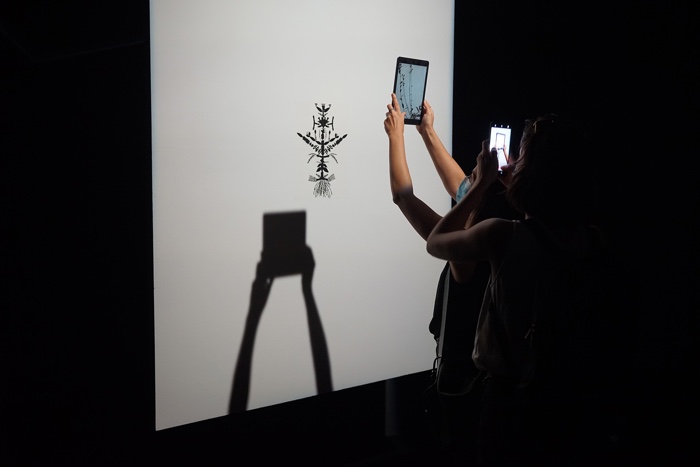
Kyriaki Goni, Data Garden, 2020. Installation view, solo show at Onassis Stegi
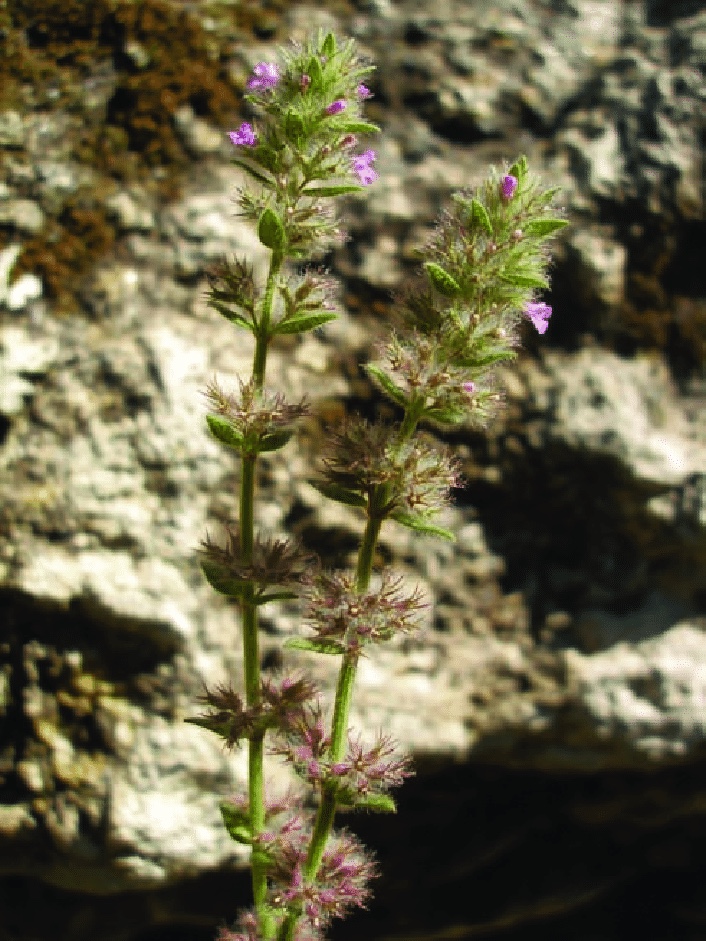
Micromeria acropolitana in its natural habitat. Photo: Lambros Tsounis
How would the close interdependency between digital data and the vegetal world that is explored in Data Garden affect what and how much of our data we decide to store? Right now, it feels like that is not something that preoccupies most of us. And would this interdependency also change the kind of relationship we have with nature?
First and foremost, Data Garden is a poetic approach to our techno-social realm. It does not provide solutions nor answers, it rather creates a space for reflection on these matters.
It is true -though not broadly discussed- that data centers are not sustainable entities. They are, on the contrary, costly and inefficient, demanding huge amounts of water, electricity, land, rare minerals, etc. Evidently, there are several good reasons to search for storage alternatives, including the field of genomics. In theory, there is no limit to the data one could store in organic or synthetic DNA, assuming of course that lab procedures would be less complicated.
In Data Garden digital information is stored in plant DNA. Through this narrative, I address the aforementioned matters of inefficiency. At the same time, I address the existence of a surveillance capitalistic system with users being simultaneously addicted producers, consumers and gatherers of information. Being able to moderate one’s own data (also known as informational self-determination) is key to the practice of Data Garden’s fictional secret community. This would probably also mean that it would be difficult to capitalize on digital memory and deploy data as a commodity.
Would this also lead to a better relationship with nature in general? Honestly, I don’t know. By storing your memory in the DNA of a living organism, a relationship of interdependence based on prudence and care might be built. An interesting analogy here is the notion of the gardener. A good gardener knows what to remove and what to tend to.
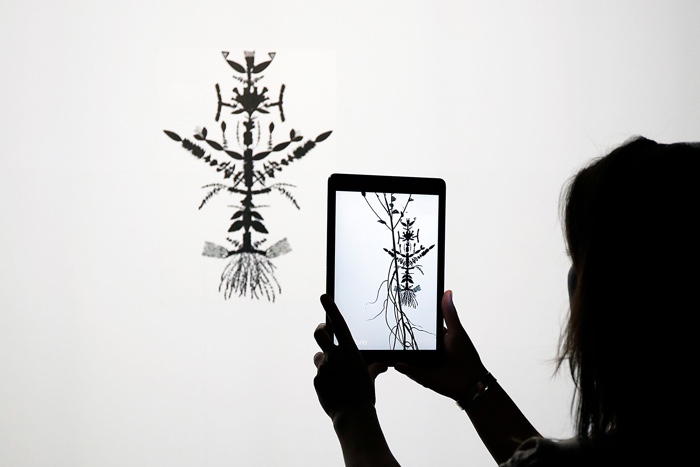
Kyraki Goni, Data Garden, Augmented Reality Portrait of the Invisible Plant. Photo Nikos Kokkas
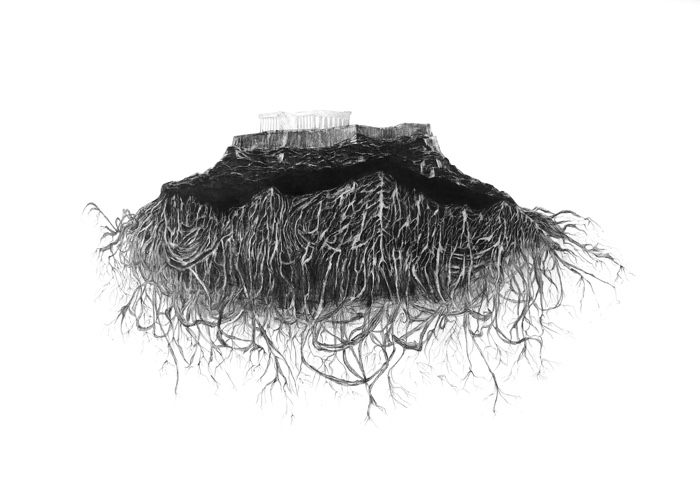
Kyraki Goni, Data Garden, A dense, hidden network of roots, 2020 drawing on paper
The augmented reality element of Data Garden is visually very seducing and intriguing. Can you tell us something about it? What guided its developments, meaning and aesthetics?
The augmented reality element is an Augmented Reality portrait of the invisible plant. Micromeria acropolitana, as mentioned above endemic to Acropolis, was presumed extinct for almost one century and was rediscovered in 2006. The plant’s ecosystem is quite fragile with only a small population detected in the area of Acropolis. According to my sources, plant-hunters threatened the ecosystem by spotting the plant to photograph it and collect its seeds. Therefore, the location of the plant remains secret in order to keep it safe. The botanists, who rediscovered and published the plant didn’t reveal the whereabouts of the plant in none of our interviews.
Despite being tempted to search for it, I decided to respect the ecosystem’s fragility. During my research, the stories around the plant, the description of its long roots penetrating the marble and rock captivated my imagination. I depicted this network of roots on the drawing A Dense, Secret Network of Roots that shows Acropolis rock with an overwhelmingly big network of roots underneath. But I wanted to depict also the plant itself.
A 3D representation of the plant is revealed through Augmented Reality to the visitor in the exhibition. The 3D model is based on the photograph of the very first sample of Micromeria kept in the Herbarium WU Institute of Botany, University of Vienna, which is also presented in the main video of the installation. Instead of the usual colors in its stalk, leaves and flowers, a different color palette is used, alluding to techniques of camouflage, as they are deployed today for refuting any recording by tracking systems of algorithmic surveillance.
The AR target, a totemic form, is constructed also from the parts of the plant. The portrait is revealed only by proximity, the app is not available in any app store. Only the visitor of the exhibition can get a glimpse of this invisible plant.
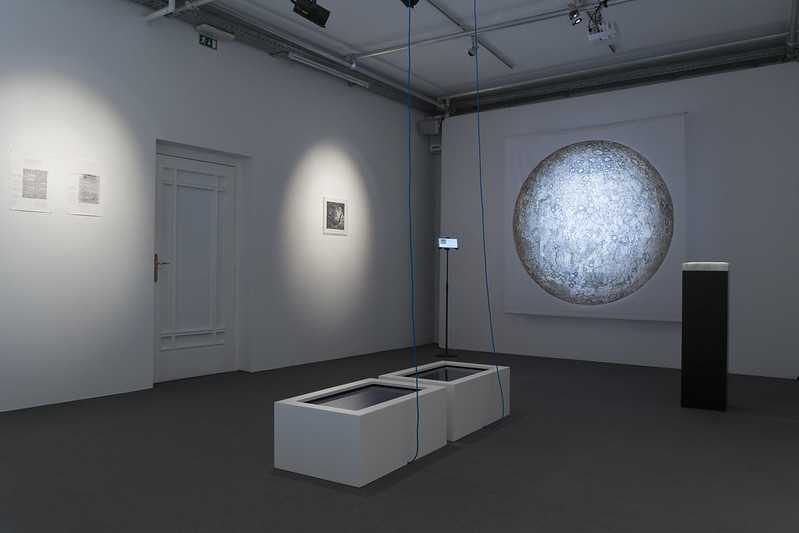
Kyriaki Goni, Counting Craters on the Moon at Aksioma Project Space in 2019. Photo: Janez Janša
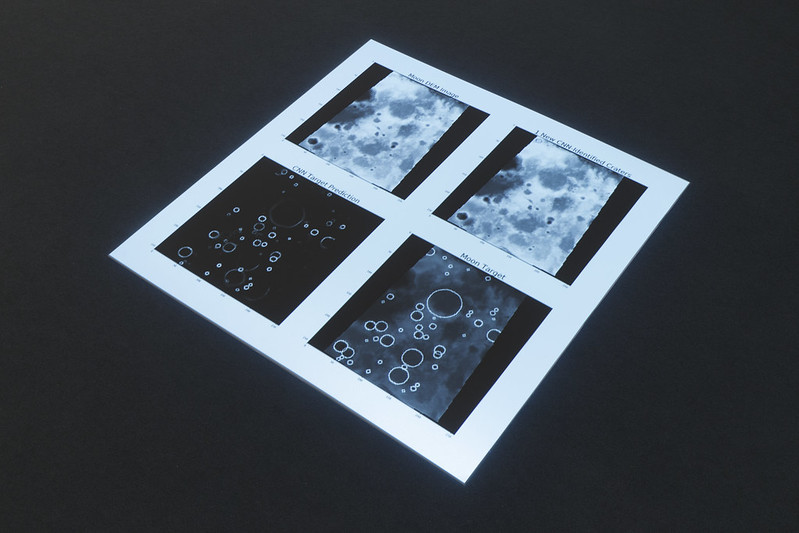
Kyriaki Goni, Counting Craters on the Moon at Aksioma Project Space in 2019. Photo: Janez Janša
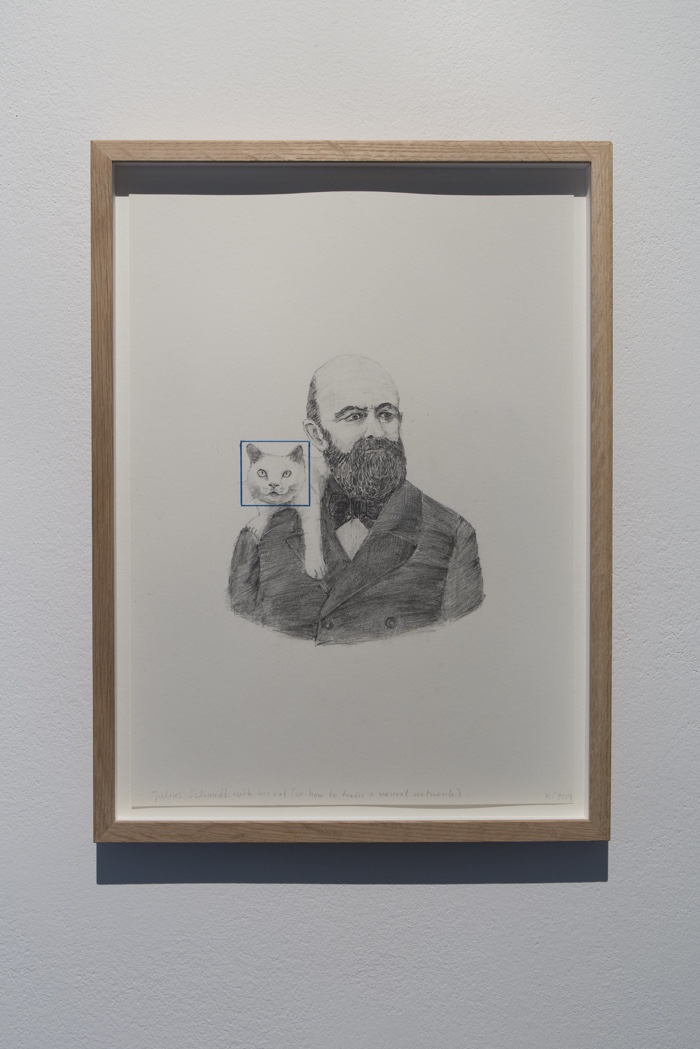
Kyriaki Goni, Counting Craters on the Moon at Aksioma Project Space in 2019. Photo: Janez Janša
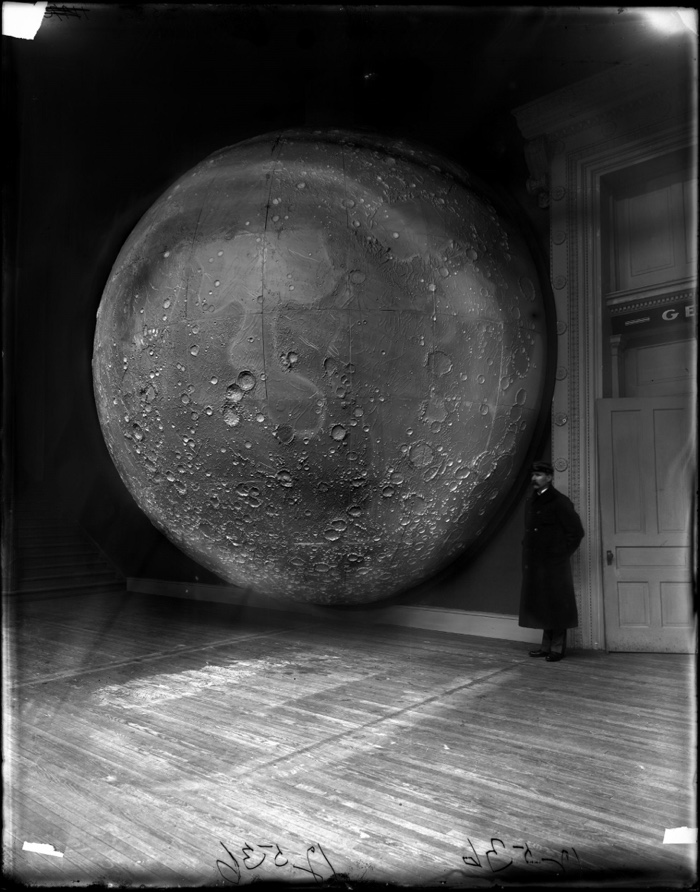
Scientific Moon model prepared by Johann Friedrich Julius Schmidt and Thomas Dickert, Germany 1898. Photo Field Museum Library Getty Images
Your work Counting Craters on the Moon runs DeepMoon, a neural network developed in 2018 to identify moon craters, on a very detailed map drawn by astronomer Johann Friedrich Julius Schmidt to see what would happen. Why did you want to confront an extraordinary map “crafted” by a man in the 19th century and an AI? What did you learn from the experiment?
Schmidt observed the Moon with the telescope and drew a 25 sheets lunar map by hand. I was deeply impressed by the extent of the detail. You could literally detect the devotion and commitment of this person to observation and scientific knowledge. He was known to the contemporary astronomical community and beyond, for his persistence in spotting every single detail. Jules Verne in Around the Moon refers to him as the Schmidt of Athens, who ‘he will leave nothing unnamed that his telescope can catch a glimpse of’ (p.236).
At the same time, I couldn’t but admire his creative skills, he was an excellent draftsman. When I suggested to the DeepMoon team to run the neural network on one section of the map, I was almost sure of the result. DeepMoon is a narrow CNN fed with a very specific type of images of the Moon. Of course, it wouldn’t be able to detect the craters on Schmidt’s map, as detailed as this map was.
At the core of the installation is an imaginary dialogue, where devotion, craftmanship, effectiveness and the notion of error are discussed. By running the neural network on Schmidt’s map, these two different visual ‘perceptions’ were brought together: Schmidt’s human vision and craftmanship and DeepMoon’s machinic vision and effectiveness.
I kept one thing from this experiment. AI might be even more effective and powerful in the future and might be able to solve problems quickly in many fields. However, AI won’t be able to actually possess specific human qualities and abilities. Therefore, synergies and complementary actions between humans and artificial intelligence systems could be a good way for moving forward. But constant control, regulations and transparency should be applied to ensure just and inclusive futures with artificial intelligence systems. Critical approach and education play an enormously important role in this. It is worth mentioning, that all the information sources of machine learning (in the case of DeepMoon the training dataset) have always been based on human skills, activities and labor. The datasets for lunar crater recognition, for instance, record the visual labor that astronomers have been performing during their research. This side of hidden labor is also mentioned among other things in the imaginary dialogue.
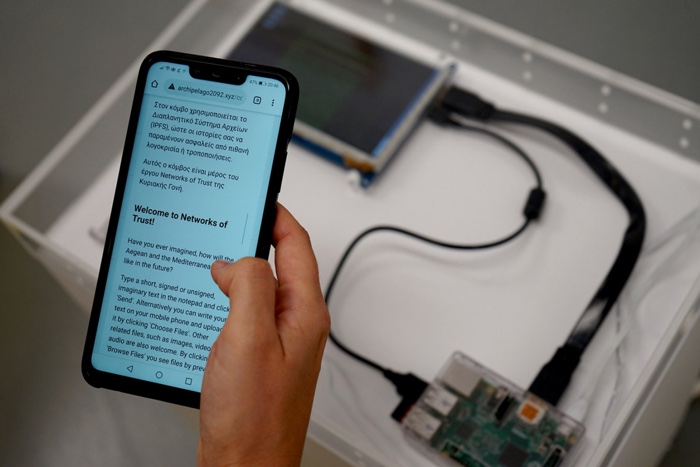
Kyriaki Goni, Networks of Trust, 2019-2021
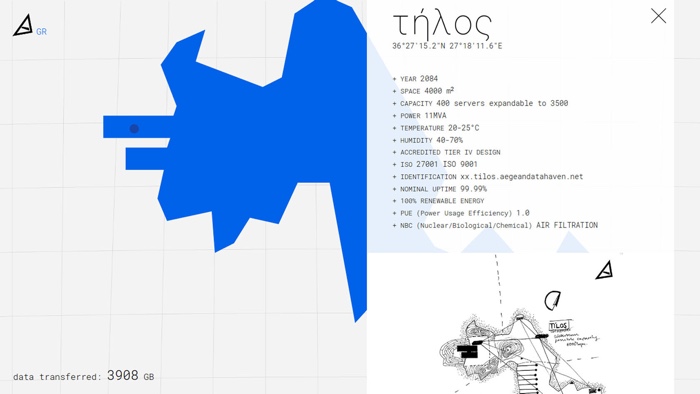
Kyriaki Goni, The Aegean Datahaven (screenshot), 2017
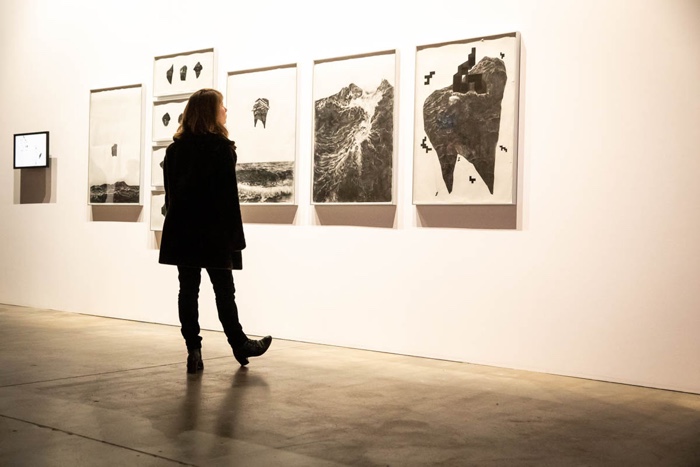
Kyriaki Goni, The Aegean Datahaven, 2017. Tomorrows-Urban Fictions for possible futures at Le Lieu Unique, curated by Daphne Dragona & Panos Dragonas
A number of your works seem to be grounded in Greek territory, history and culture. Whether it’s an archipelago or the Acropolis, these are not territories that we do not always associate with technology. What does this very local context bring to your understanding and critique of a phenomenon as global as technology?
This connection of the local and global context started rather unconsciously, in my work The Aegean Datahaven (2017). In the last years, I have come to realize that, what had started unconsciously back then, became a great tool for me to reflect and understand deeper, to investigate and communicate further phenomena as global as technology.
The Mediterranean basin and Greece are areas of great sensitivity both politically and financially. At the same time are areas of great cultural and historical importance. Greece is an interesting case, being at the same time at the intersection of East and West and the birthplace of modern western values. The country, part of the European South and periphery, has faced many years of financial crisis.
On the one hand, is important to keep in mind that the periphery is the place where, climate urgency, financial crisis and infrastructural gaps reveal themselves to the utmost extent offering maybe raw insights to possible futures.
On the other hand, a sensitive and careful approach of the local can actually enable a sensitive approach and possible understanding of the global. I feel that the tools that one inherits from their ancestors, history, territory, topography and geography can provide a point of reference, a framework to process and investigate global trends or events. Meaning not merely understanding the global, but interrogating the current global conditions dictated by narrow definitions and monopolies of tech that are actually highly exclusive. By focusing on and recovering locality and ancestries we might have a chance to build more inclusive futures. This is what I am trying to do in my work.
Consider for instance, a recent work of mine, Data Garden (2020). Despite taking place locally, on Acropolis, the work discusses global notions of democracy and power being challenged in the digital era. In this way the global becomes local and vice versa providing different perspectives and points of view. Additionally, the climate crisis is central in this work. The plant in the narrative is part of a family with a center of diversity in the Mediterranean region. This could possibly open a discussion on the climate urgency in the peripheries globally. Now, in the post-pandemic era, we might need to rethink localized and situated practices in general.
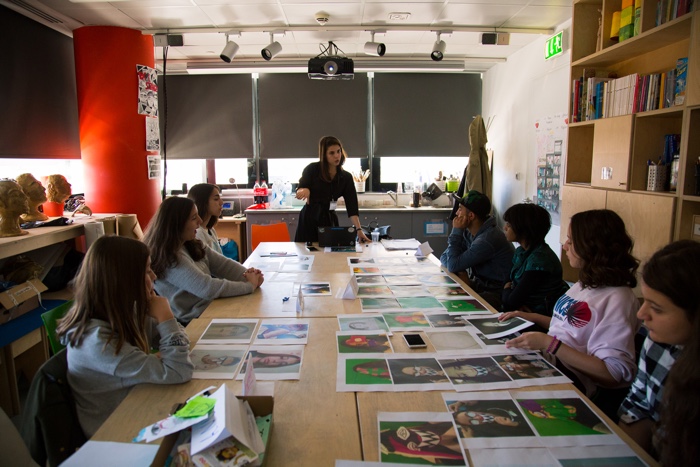
Workshop From the Selfportrait to Selfie to Antiselfie. Discussing the selfie as a process, Onassis Stegi, 2017. Photo Stavros Petropoulos
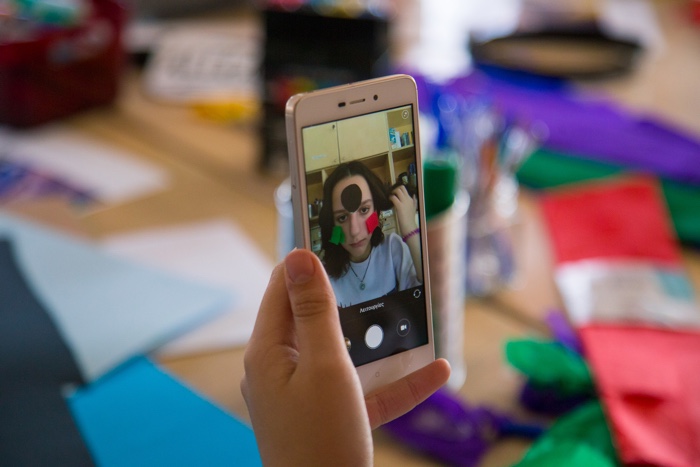
Workshop From the Selfportrait to Selfie to Antiselfie. Experimenting with the algorithm, Onassis Stegi, 2017. Photo Stavros Petropoulos
Workshops seem to play an important role in your artistic practice. Why is that?
Workshops are developed as part or extension of my artistic practice. I believe that workshops provide a platform for connection and further interaction with broader audiences, who won’t necessarily visit an art exhibition.
In workshops, I try to create the spatial and temporal conditions that allow for a meaningful dialogue to take place, for different views to be exchanged. The focus, as in my art practice, is technology and the way it shapes our societies. These workshops have not technophobic nor technophilic tendencies, the intention is to transfuse a more critical approach and to discuss collectively as (digital) citizens today. As I mentioned above, technology can be a good thing, as long as we are informed and vigilant so that is possible to affect politics and regulations. In these workshops, it is important to me to bring together the aesthetic, poetic and tactical forms.
From the Selfportrait to Selfie to Antiselfie or Building Networks of Trust are two of my favorite workshop series. In the first one, we approach the ways individual visibility and agency intertwine with digital citizenship and privacy. Moving from the first self-portraits in art and photograph to #selfie, we document our self, stage our selfie, hack our selfie and looking into our selfie’s metadata.
In Building Networks of Trust, I bring real-time science-fiction into practice as another possibility of community building. Taking into consideration population movements, climate crisis and tech advancements, participants are invited to create speculative narratives about the possible futures in their area. The storytelling and listening aspects are central here. Participants and community meet in reading sessions and build networks of trust through the act of listening. The stories are uploaded to the nodes of Networks of Trust.
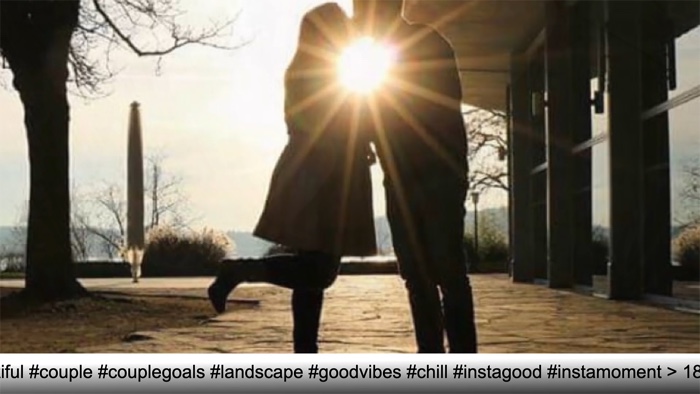
Kyriaki Goni, The Perfect Love #couplegoals, videostill, 2020
Any upcoming field of research, event or project you’d like to share with us?
I certainly look forward to receiving the contributions on the nodes of the newly commissioned Networks of Trust Upon the Ocean for the 13th Shanghai Biennale, which will be on until the 25th of July.
June is quite busy month. It starts with Linz FMR where I present a new public intervention with the title Voices (Imagining Possible Futures). I picked 10 short phrases from the audiences’ stories hosted on the nodes of Networks of Trust and printed them on banners. It is an invitation to reflect and discuss. To read aloud and listen in the public space.
My works The Portal or Let’s stand still for the whales and The Perfect Love #couplegoals are part of the exhibition Modern Love at Talinna Konsthalle (19 June-5 September) curated by Katerina Gregos. Counting Craters on the Moon will be part of an exhibition in Athens at the end of June, curated by Irini-Mirena Papadimitriou.
But also at the studio is a busy period. I am currently working on a new project for the Art Residency of Ars Electronica supported by Deutsche Telekom. I focus on AI vocalic interfaces, algorithmic justice and gender stereotypes.
At the same time, I am very pleased to be part of a bright and active community supported by The New New fellowship (Bertelsmann Stiftung and Superrr Lab). This program brings together people from across Europe to draft their own visions for just digital futures.
Thanks Kyriaki!
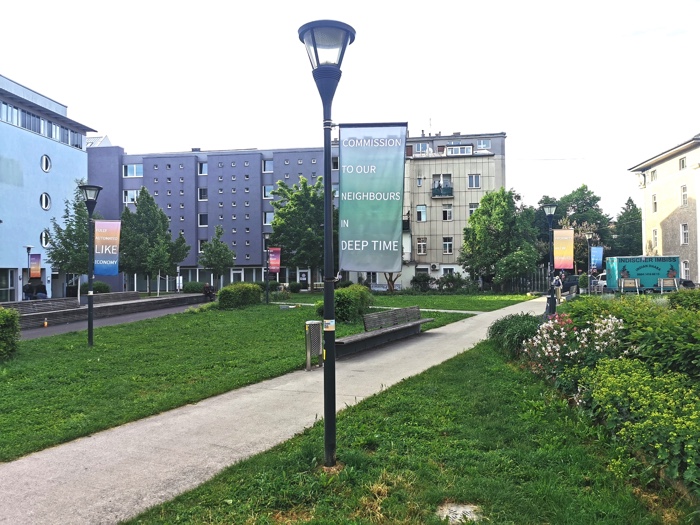
Kyriaki Goni, Voices (Imagining Possible Futures), 2021. At FMR21 in Linz. Photo: (c) Jürgen Grünwald

Kyriaki Goni, Voices (Imagining Possible Futures), 2021. At FMR21 in Linz. Photo: (c) Jürgen Grünwald
If you’re anywhere near Linz (Austria), check out Kyriaki Goni’s new work Voices (Imagining Possible Futures) at the second edition of FMR, the biennial festival for art in digital contexts and public spaces. The festival will take place from 1 to 6 june 2021. FMR 21 is curated, programmed and organised by qujOchÖ, servus.at, the Atelierhaus Salzamt, the Department of Media Theories at the University of Arts Linz and the Sturm und Drang Galerie.

